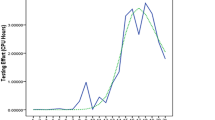Abstract
Software reliability models are used to estimate and predict the reliability, number of remaining faults, failure intensity, total software development cost, etc., of a software. Testing coverage is very important for both software developers and customers of software products. Testing converge is a measure that enables software developers to evaluate the quality of tested software and determine how much additional effort is needed to improve the reliability of the software. This paper proposes a software reliability growth model based on a non-homogeneous Poisson process (NHPP) that incorporates a logistic–exponential testing coverage function with imperfect debugging. The proposed model relates the test coverage to fault detection phenomena in debugging. Goodness-of-fit test of the proposed model is conducted using different criteria for two sets of software failure data. The proposed model is compared with other existing NHPP models. A software cost model incorporating testing coverage and an optimal release policy based on the number of remaining faults are developed.


Similar content being viewed by others
References
Bhaskar T, Kumar UD (2006) A cost model for N-version programming with imperfect debugging. J Oper Res Soc 57(8):986–994
Cai X, Lyu MR (2007) Software reliability modelling with test coverage experimentation and measurement with a fault tolerant software project. In: Proceedings of international symposium on software reliability engineering, pp 17–26
Chatterjee S, Misra RB, Alam SS (1997) Joint effect of test effort and learning factor on software reliability and optimal release policy. Int J Syst Sci 28(4):391–396
Fujiwara T, Park JY, Park JH (2007). Evaluation and applications of MVFs in coverage for coverage-based NHPP SRGM frameworks. In: Proceedings of 5th international conference on software engineering research, management and applications, pp 385–392
Goel AL, Okumoto K (1979) Time-dependent error-detection rate models for software reliability and other performance measures. IEEE Trans Reliab 28(3):206–211
Gokhale G, Trivedi KS (1999) A time/structure based software reliability model. Ann Softw Eng 8:85–121
Gokhale SS, Philip T, Marinos PN, Trivedi KS (1996) Unifications of finite failure non-homogeneous Poisson process models through test coverage. In: Proceedings of the 7th IEEE international symposium on software reliability engineering, White Plains, New York, pp 299–307
Huang CY, Lyu MR (2005) Optimal release time for software systems considering cost, testing-effort, and test efficiency. IEEE Trans Reliab 54(4):583–591
Kapur PK, Bhalla VK (1992) Optimal release policy for flexible software reliability growth model. Reliab Eng Syst Saf 35:49–54
Kapur PK, Garg RB (1989) Cost reliability optimum release policies for a software system under penalty cost. Int J Syst Sci 20:2547–2562
Kapur PK, Garg RB, Kumar S (1999) Contribution to hardware and software reliability. World Scientific Press, Singapore
Lan Y, Leemis L (2008) The logistic–exponential survival distribution. Naval Res Logist 55(3):252–264
Li H, Li Qiuying, Lu M (2008) Student paper: software reliability modelling with logistic test coverage function. In: Proceedings of 19th international symposium on software reliability engineering, pp 319–320
Lyu MR (1996) Handbook of software reliability engineering. IEEE Computer Society Press/McGraw Hill, New York
Malaiya YK, Li MN, Bieman JM, Karcich R (2002) Software reliability growth model with test coverage. IEEE Trans Reliab 51(4):420–426
Okumoto K, Goel AL (1980) Optimal release time for software system based on reliability and cost criteria. J Syst Softw 1:315–318
Park JY, Hwang YS, Fujiwara T (2007a) Generalization of the testing-domain dependent NHPP SRGM and its application. Int J Reliab Appl 8(1):53–66
Park JY, Lee G, Park JH (2007b) A class of discrete time coverage growth functions for software reliability engineering. Korean Commun Stat 14(3):497–506
Park JY, Lee G, Park JH (2008a) A general coverage-based NHPP SRGM framework. Commun Korean Stat Soc 15(6):875–881
Park JY, Lee G, Park JH (2008b) A class of coverage growth functions and its practical application. J Korean Stat Soc 37:241–247
Pham H (1996) A software cost model with imperfect debugging random life cycle and penalty cost. Int J Syst Sci 27(5):455–463
Pham H (2006) System software reliability. Springer, London
Pham H, Zhang Z (1999) A software cost model with warranty cost. IEEE Trans Comput 28:71–75
Pham H, Zhang Z (2003) NHPP software reliability and cost models with testing coverage. Eur J Oper Res 145:443–454
Pham H, Nordmann L, Zhang X (1999) A general imperfect software debugging model with S-shaped fault detection rate. IEEE Trans Reliab 48(2):169–175
Rafi SM, Rao KN, Akthar S (2010) Software reliability growth model with logistic–exponential test-effort function and analysis of software release policy. Int J Comput Sci Eng 2(2):387–399
Wei DP, Liu LL (2010) An improved software reliability model incorporating debugging time lag. In: Second international conference on advanced computer control (ICACC), vol 3, pp 83–86
Xie M (1991) Software reliability modelling. World Scientific Press, Singapore
Yamada S, Osaki S (1985) Cost-reliability optimal release policies for software systems. IEEE Trans Reliab 34(5):422–424
Yamada S, Ohba M, Osaki S (1983) S-shaped reliability growth modelling for software error detection. IEEE Trans Reliab 12:422–424
Acknowledgments
Authors acknowledge Indian School of Mines, Dhanbad, India, for providing necessary facilities for this work. Also, authors are thankful to reviewers for their valuable suggestion to improve the paper.
Author information
Authors and Affiliations
Corresponding author
Rights and permissions
About this article
Cite this article
Chatterjee, S., Singh, J.B. A NHPP based software reliability model and optimal release policy with logistic–exponential test coverage under imperfect debugging. Int J Syst Assur Eng Manag 5, 399–406 (2014). https://doi.org/10.1007/s13198-013-0181-6
Received:
Published:
Issue Date:
DOI: https://doi.org/10.1007/s13198-013-0181-6




